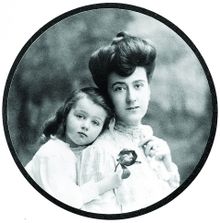Edith Stuyvesant Vanderbilt

Edith Stuyvesant Vanderbilt (born January 17, 1873 as Edith Stuyvesant Dresser in Newport , Rhode Island , † December 21, 1958 in Providence , Rhode Island) was an American art patron , suffragette and high society lady in New York society .
Life
Edith Stuyvesant came from a prominent family. Her father was Major George Warren Dresser (1837-1883), son of George Andrew Dresser and his wife Hannah Brown. He was a US Senator and heir to a great fortune. Her mother Susan Fish LeRoy (1834-1883) was the daughter of the wealthy merchant Daniel LeRoy and his wife Susan Elizabeth Fish, a daughter of Lieutenant Colonel Nicholas Fish , a New York lawyer, councilor and general in the American Revolutionary War and his wife Elizabeth Stuyvesant, a great-great-granddaughter of Petrus Stuyvesant , first governor and founder of the city of New York City . Edith was a niece of the politician Hamilton Fish (1808-1893) and Daniel LeRoy Dresser, President of the Trust Company of the Republic.
Edith Vanderbilt had three sisters:
- Susan LeRoy Dresser ⚭ 1899 Viscount Romain d'Osmay, French nobleman
- Natalie Bayard Dresser (1869–1950) ⚭ 1897 John Nicholas Brown, President of the Lonsdale Company
- Pauline Georgine Warren Dresser ⚭ 1897 Rev. George Grenville Merrill, pastor of St. Mary's Protestant Episcopal Church in Tuxedo, New York
Her parents died on May 27, 1883 in a racing accident off the coast of Rhode Island. Ten-year-old Edith grew up with her sisters with their maternal grandmother, Susan Elizabeth LeRoy (1805-1892). Her childhood revolved around perfect behavior and social representation. She visited the French internant Les Ruches in Fontainebleau from Mademoiselle Marie Souvestre .
On June 1, 1898, she married in Paris the wealthy heir George Washington Vanderbilt II (1862-1914), youngest son of William Henry Vanderbilt and his wife Maria Louisa Kissam. The connection resulted in a daughter, Cornelia Stuyvesant Vanderbilt (1900–1976). Together with her husband she traveled a lot and quickly made contact with European high society in London , Paris, Venice , Rome , Capri and Munich . The banquets , dance balls , garden parties, dinners , fox hunts, dance evenings and costume parties of the European high and American money aristocracy were famous and filled the social columns of the newspapers. To escape the hustle and bustle of life, the couple retired to their Biltmore Estate , built by architect Richard Morris Hunt in Asheville , North Carolina .
Together with Alva Vanderbilt Belmont (1853-1933), the first wife of her brother-in-law William Kissam Vanderbilt (1849-1920), Edith engaged in successful combat with Anna Howard Shaw , Lucy Burns and Alice Paul and a number of other women between 1912 and 1920 about women's suffrage in the USA. She maintained a particularly friendly relationship with her niece Consuelo Vanderbilt (1877–1964), Lady Spencer-Churchill, Duchess of Marlborough and Gertrude Vanderbilt Whitney . Immortalized in portraits and photographs by numerous artists, Edith Stuyvesant Vanderbilt became famous as the most painted woman in the United States. She was personally friends with many artists, including James McNeill Whistler , Giovanni Boldini , John Singer Sargent , Cecil Beaton , Auguste Renoir and Adolphe de Meyer .
In the spring of 1912, the couple toured Europe and booked a first class passage on the RMS Titanic , which left Southampton in the south of England for New York on April 10, 1912. In the northern French port city of Cherbourg , the couple wanted to board the luxury liner. Through a telegram from Edith's sister Susan, who expressed a premonition, the Vanderbilts abandoned their plan and canceled the trip on the day of departure. Her luggage and her servant Edwin Wheeler were already on board, Wheeler was now to supervise the transfer of his employer's luggage to New York. In the early morning hours of April 15th, the ship collided with an iceberg; of the 2207 people on board, over 1500 were killed, including Edwin Wheeler.
In 1914, her husband died of an anesthetic mistake during an operation . On October 22, 1925 she married again in London with the US Senator from Rhode Island, Peter Goelet Gerry (1879-1957). The marriage was a happy one, according to all reports.
Edith Stuyvesant Gerry died on December 21, 1958 in Providence. The following year, the painting The Rest by Édouard Manet was donated from her estate to the Rhode Island School of Design Museum there . She donated the picture The Tragedy by the same artist to the National Gallery of Art in Washington DC , as well as a self-portrait and a portrait of her first husband George Washington Vanderbilt II by James McNeill Whistler .
Painting by the Edith Stuyvesant Gerry Foundation
literature
- Philip van Rensselaer: That Vanderbilt Woman. Playboy Press et al., Chicago IL et al. 1978, ISBN 0-87223-502-5 .
- Amanda Mackenzie Stuart: Consuelo and Alva Vanderbilt. The Story of a Daughter and Mother in the Gilded Age. Harper Collins Publishers, New York NY 2005, ISBN 0-06-621418-1 .
- Consuelo Vanderbilt Balsan: The Glitter and the Gold. Harper, New York NY 1952 (Also: George Mann Books, Maidstone 1973 ISBN 0-7041-0002-9 ).
Web links
- Edith Stuyvesant (English)
- Biltmore Estate (English)
| personal data | |
|---|---|
| SURNAME | Stuyvesant Vanderbilt, Edith |
| ALTERNATIVE NAMES | Edith Dresser (maiden name); Edith Stuyvesant; Edith Vanderbilt; Edith Gerry |
| BRIEF DESCRIPTION | American art patron, suffragette and high society lady of New York society |
| DATE OF BIRTH | January 17, 1873 |
| PLACE OF BIRTH | Newport , Rhode Island |
| DATE OF DEATH | December 21, 1958 |
| Place of death | Providence , Rhode Island |




